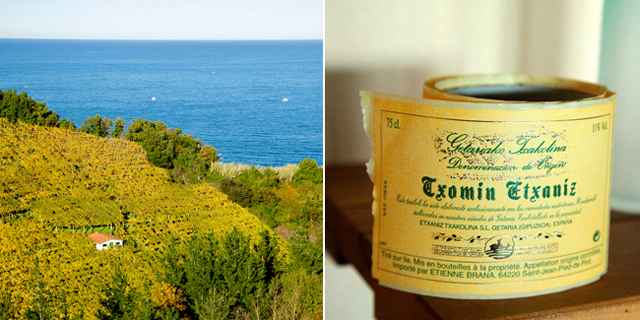“What I love about Txakoli,” says Dominican-born Jason Arias, manager of the Basque-themed restaurant Txikito in New York City, “is the social aspect. In the Basque country, people have a connection to what they eat and drink, and they include the people they love in that story.” His boss, Txikito chef and co-owner Alex Raij, agrees and puts it plainer: “I have rarely seen a wine make people so giddy and embrace one another in the same way,” she says.
When Raij and her Basque-born husband Eder Montero opened Txikito in 2009, few customers had heard about the strangely spelled wine with the tangle of hard consonants. Fewer still knew how to pronounce it: cha-ko-lee. And only a tiny handful knew anything about the origins and history of Txakoli and how it’s best served. Txikito was on a mission, says Raij, to be “ambassadors for the Basque way of life, and that includes Txakoli. [At Txikito, we focus] exclusively on Basque wines, including Txakoli, and serve them with traditional dishes, in traditional glassware, pouring in the traditional style.”
For most of its history, says Arias, who has met several Txakoli producers in Spain’s Basque region during tasting trips, Txakoli was a winemaker’s wine: a small-batch production shared among friends and family, not available for export. Even now, with the increasing popularity of Txakoli outside Spain, “about 85% of the Txakoli production is still consumed within the region,” says Gil Avital, wine director at New York City’s Tertulia restaurant. “It is a very simple ‘peasants’ wine, relatively low in alcohol so one can wake up early… and still be able to work in the vineyards.”
Txakoli’s signature characteristics—that low alcohol content, effervescence, a minerally profile and acidic edge evocative of cider—are what make it perfect for sharing with friends. This isn’t a wine you drink alone; it demands sharing. Txakoli plays an important role in the social life of Basque communities, says Avital. “Neighbors and friends meet at the local tapas bars and share a few glasses together at the end of the work day before heading home for dinner,” he explains.
Next, how to enjoy Txakoli and a video on how to pair it…
[pagebreak]Americans trying Txakoli for the first time are often charmed by the social aspect of the wine, as well as the particular rituals that accompany serving it. Though it’s a wine that Raij describes as “generally unpretentious,” Txakoli is poured with flair and flourish. The effervescence of the wine prompted the signature pouring style for Txakoli: a high, steady, streaming pour into a wide tumbler. “This becomes a memorable and unique experience for people and they remember it when they see it elsewhere,” says Raij. They tend to want to share their discovery and the experience of Txakoli with friends, and Raij and Arias both have plenty of stories about memorable moments they’ve witnessed among guests enjoying Txakoli at Txikito.
Txikito features six to eight txakolis on its wine list at any given time. Arias says that there are so many producers now that the restaurant can’t feature them all simultaneously, so the Txakolis are rotated on and off the wine list. In addition to the traditional white Txakolis, Txikito carries rosés, still, red, and dessert Txakolis, which are even less known than the whites. All of the Txakolis they import are featured at their annual Txikifest, which just celebrated its third year. The festival, dedicated to Basque food and, of course, to Txakoli, even attracts Basque country winemakers. At Tertulia, Avital currently has seven Txakolis–four whites, two rosés, and one red—on the menu.
Txakoli is most widely available in New York City, but can occasionally be found on the wine lists of other Basque-inspired restaurants around the country. Txakoli is on the wine list at José Garces’ Philadelphia restaurant, Tinto; at Estadio in Washington, D.C., and Allium in Great Barrington, Massachusetts. Outside restaurants, check your liquor store for its availability. And here, check out our Txakoli 101 video to see what Arias recommends pairing Txakoli with for a late summer Basque-themed party, and to learn how to pour Txakoli the authentic way.


![Making Mealtime Matter with La Familia: Easy Sofrito [Video]](https://thelatinkitchen.com/wp-content/uploads/2015/10/sofrito-shutterstock__0-500x383.jpg)
![Easy Latin Smoothies: Goji Berry Smoothie [Video]](https://thelatinkitchen.com/wp-content/uploads/2015/12/goji_berry-shutterstock_-500x383.jpg)
















![Fun and Fast Recipes: Fiesta Cabbage Salad [Video]](https://thelatinkitchen.com/wp-content/uploads/2015/11/fiesta_cabbage_slaw-shutterstock_-500x383.jpg)









